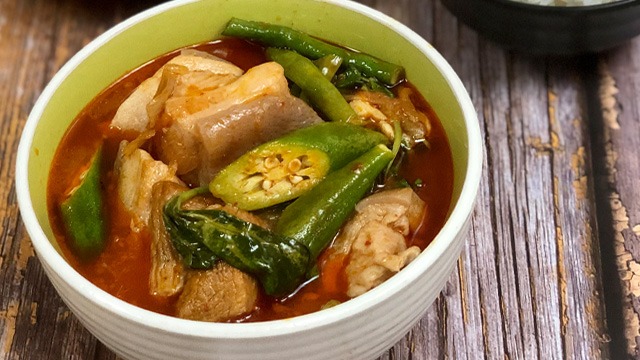Explore the Rich Preference of Filipino Food With These Must-Try Recipes
Filipino food uses an impressive tapestry of flavors that show the country's rich cultural heritage. Each meal informs a story, from the tasty deepness of Adobo to the refreshing tang of Sinigang, welcoming cooking enthusiasts to discover a varied variety of tastes. The cheery allure of Lechon and the comforting heat of Kare-Kare even more improve this gastronomic journey, while the dynamic Halo-Halo provides a pleasant verdict to any dish. As we take into consideration the subtleties of these renowned recipes, one have to ponder exactly how they not only please the taste buds however additionally link us to a broader social story.
Adobo: The Iconic Recipe
Adobo has become the essential recipe of Filipino cuisine, captivating tastes buds both in your area and abroad. This cherished recipe is identified by its distinct mix of tasty, sour, and a little pleasant tastes, achieved via a meticulous marination procedure. Generally, adobo is prepared making use of poultry or pork, although variants exist that include seafood and veggies.
The fundamental components of adobo include soy sauce, vinegar, garlic, bay leaves, and black pepper, which with each other create a rich and fragrant sauce. The food preparation technique typically includes simmering the meat in the sauce, allowing it to absorb the complicated tastes while coming to be tender. This procedure not only boosts the preference yet additionally works as a natural preservative, making adobo an excellent dish for storage space.
Adobo is usually served with fit to be tied rice, which enhances its robust taste profile. Whether taken pleasure in at home or in dining establishments, adobo stays a staple that symbolizes the significance of Filipino hospitality, making it a must-try for any individual discovering this vibrant food.

Sinigang: A Tangy Joy
An additional keystone of Filipino cuisine is sinigang, a recipe commemorated for its distinct tangy flavor. This mouthwatering soup is commonly made with a range of meats, consisting of pork, beef, shrimp, or fish, and is defined by its sour broth, which commonly stems from tamarind, eco-friendly mango, or calamansi. The balance of acidity and umami produces a revitalizing contrast that is both soothing and stimulating.
Sinigang is frequently enriched with a variety of fresh vegetables such as radish, eggplant, water spinach, and string beans, adding not only to the recipe's taste account but also to its dietary value - Filipino food recipes. Each household might have its own variation, with regional variations that reflect regional active ingredients and cultural influences
The prep work of sinigang involves simmering the chosen meat up until tender, adhered to by the addition of the souring agent and veggies. This approach permits the flavors to combine magnificently, causing a passionate and rewarding meal. Traditionally offered with steamed rice, sinigang personifies the essence of Filipino hospitality and is a precious staple, usually enjoyed throughout family members gatherings and special events.
Lechon: The Joyful Roast
Lechon, often concerned as the centerpiece of cheery Filipino parties, is a succulent roasted pig understood for its crispy skin and tender, savory meat. This legendary meal is deeply rooted in Filipino society, commonly beautifying tables throughout birthdays, wedding celebrations, and significant vacations. The prep work of lechon is an art type, needing precise attention to detail, from marinating the pig with a blend of flavors to making sure an also roast over an open flame or in a specialized oven.
Normally, the pig is experienced with a blend of salt, pepper, and regional natural herbs, giving a rich flavor that enhances its all-natural juiciness. The cooking procedure can take a number of hours, throughout which the skin transforms into a perfectly crunchy layer, producing a delightful comparison to the delicious meat beneath.
Lechon is typically served with a side of liver sauce or vinegar dip, enhancing its mouthwatering profile. It is not just a dish yet a common experience, as friends and families gather around to enjoy this superb dish. The aroma of lechon wafting through the air is an invitation to delight, making it a beloved symbol of celebration in Filipino society.
Kare-Kare: Oxtail Stew
Kare-Kare, a rich and hearty oxtail stew, holds a special place in Filipino culinary custom, celebrated for its special flavor profile and vibrant presentation (Filipino food recipes). This dish is defined by its luscious peanut sauce, which is developed by grinding baked peanuts or using peanut butter, offering it a creamy and nutty significance. Generally, kare-kare attributes tender oxtail, although variations might include tripe or beef shank, each adding to the stew's deepness of flavor
The prep work of kare-kare normally involves slow-cooking the meat until it ends up being incredibly tender. The enhancement of a variety of veggies, such as eggplant, string beans, and banana hearts, not only boosts the stew's nutritional worth however likewise its aesthetic allure. Offered with a side of bagoong, or fermented shrimp paste, kare-kare perfectly balances its rich, tasty notes with a salty kick.
Often enjoyed during special events and household celebrations, kare-kare symbolizes the significance of communal eating in Filipino society. Its delightful intricacy and calming warmth make it imp source a meal that is not just pleasing to the taste buds yet additionally evokes a feeling of fond memories for several Filipinos around the globe.

Halo-Halo: A Sweet Treat
Halo-halo is frequently considered as the perfect Filipino treat, commemorated for its vibrant mix of appearances and tastes - Filipino food recipes. This wonderful concoction is a best representation of the Philippines' abundant why not try these out culinary heritage, integrating numerous components that integrate to develop a revitalizing and indulgent reward, especially during heat
At its core, halo-halo attributes crushed ice covered with a selection of components, consisting of sweetened beans, jellies, fruits like bananas and jackfruit, and velvety leche flan. A generous inside story of ube (purple yam) gelato crowns the mix, adding a rich, creamy taste that raises the treat. The layering of components not just produces a banquet for the eyes but likewise provides an intricate interaction of sweetness and texture in every spoonful.
Commonly offered in a glass, halo-halo urges diners to blend the components prior to enjoying. This common facet improves the dessert's appeal, as everyone's variation can be distinctly tailored. Whether delighted in as a road food extravagance or a special celebration treat, halo-halo remains a precious symbol of Filipino culture, welcoming everyone to explore its delightful and varied tastes.
Verdict
